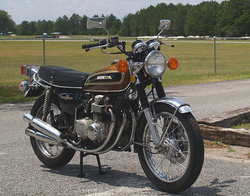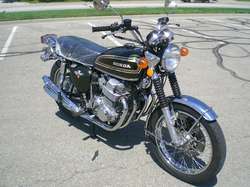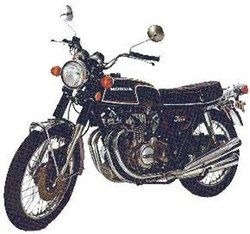The CB750/500/550/350/400 page!
The First Series of "In Line Four Cylinder" Bikes From 1969 To 1978 Changed The World of Motorcycling!
Beginning with the CB750 in 1969 to the CB400 Super Sport from 1975 to 1977, the Honda "in line four cylinder" machines changed direction of motorcycle development. After the CB750 (1969-1978), there was the CB500(1971-1973), followed by the CB550(1974-1977), and finally the little CB350 (1972-3) and the sportier version of the bike, the CB400 Super Sport (1975 to 1977). These bikes set a new course away from the British twin to a more modern, more powerful, and much higher performance machine. Check out the "CB750 Preservation Society" web site: www.cb750.org
another resource: www.sohc4.net
The 1969 through 1978 series Honda "fours" have been the source of many specialty motorcycle groups. There are CB750 groups, groups for the CB500/550, and groups which focus on the 350/400 series. These bikes have very clean designs which are still modern motorcycles today. All of these bikes are great foundations for cafe racers, customs, and bikes worthy of restoration for "vintage" shows!
Below is the ground breaking CB750!
Around 10 months prior to the unveiling of the CB750, the Triumph Trident and BSA Rocket 3 were introduced. They did not produce nearly as much interest because they were basically old designs with an added cylinder. Still OHV, oil leaking, 4 speed bikes. Furthermore, they were not sporty looking, but their squared off styling was not attractive to the American market. They were not bad motorcycles, just too little too late! Few were available in dealerships! The British companies were not able to manufacturer the volume needed. So here comes the Honda CB750. It was equipped with an OHC engine with 4 cylinders, a 5 speed transmission, electric starter, disc brakes, and a modern sporty look! It was also every bit as fast as the Triumph or BSA's, in some tests the Honda was faster. The Honda becomes the first "Super Bike" and the new standard to beat. They were also redily available in the dealerships. They sold at a rate over five times that of the Triumph, BSA, and Norton combined. Several years earlier, the British companies felt like the Japanese builders couldn't build big bikes, now they knew in a big way that they could. The CB750 was the initial death blow to British control of the big bike market. Within three years, the Japanese totally dominated the world of motorcycling. The big CB was king till the Kawasaki Z-1 came along in 1973.
The 1973 CB750 below is owned by Mark Bayer:
The CB550 was a super clean, well designed motorcycle!
From 1971 till 1977, little changed in this series of bikes other than color, a few more cc's along the way, and a few minor details.
These 1969 to 1978 Fours set a new course for all of motorcycling!
The "fours" were not the fastest bikes (except for the CB750 in it's first few years) availabile, but were user friendly, reliable, required little maintenance, were smooth, and nice looking machines. Most sold well and were used as models for many other manufacturers. The Binelli "six" was just a copy of the CB500 + two more cylinders! The Kawasaki Mach III (a 500cc machine in the beginning) was much faster than any other bike it's size (it might even take the CB750 on a good day), but was a handling disaster, were known to be unreliable, were scarry to ride, and were not good all around utility bikes thus leaving the Honda's as much more practical and usable daily riders.
Many CB's are used for vintage racing because of their ability to produce reliable horse power!
When Cycle World tested the CB550 in 1973, it ran the quarter mile in 14.22 seconda at 91mph. It was as fast as a Triumph Bonneville but more reliable, less fussy, and would not break down if high revs were sustained. It was hard to hurt these bikes. The Hondas were not nearly as fast as the Kawasaki Mach III, but were much more user friendly, smoother as a touring bike, got much better gas milage, and were safer handling machines! I have come across a few CB500/550's still in use, and I have not found one yet which has required a rebuild.
The CB350 was never a hit!
Shown below is the little CB350 four. It was no faster than the 350 twin but was only a little smoother. They never sold well. In 1975 to 1977 the bike grew to 400cc and was much sportier. The CB400 Super Sport is quite a collector machine today. The 400 was a greatly improved bike and reflected the bikes to come in the next decade!


